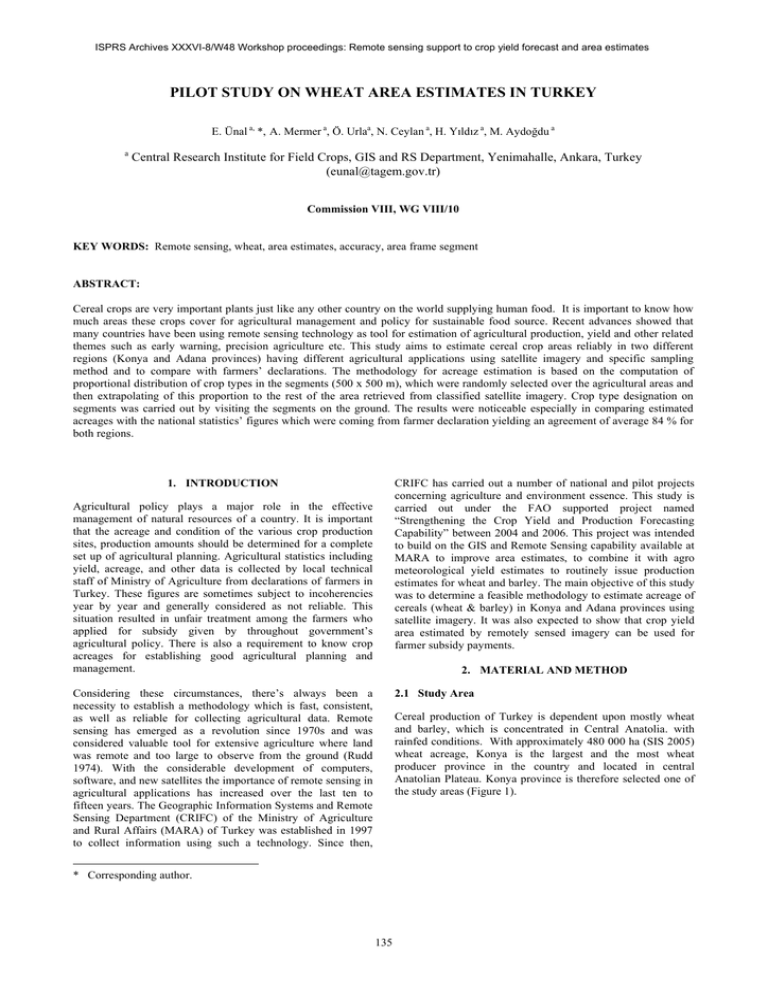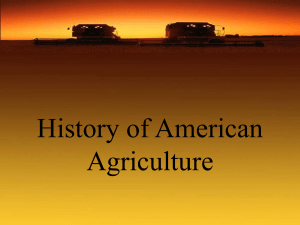Document 11869404
advertisement

ISPRS Archives XXXVI-8/W48 Workshop proceedings: Remote sensing support to crop yield forecast and area estimates PILOT STUDY ON WHEAT AREA ESTIMATES IN TURKEY E. Ünal a, *, A. Mermer a, Ö. Urlaa, N. Ceylan a, H. Yıldız a, M. Aydoğdu a a Central Research Institute for Field Crops, GIS and RS Department, Yenimahalle, Ankara, Turkey (eunal@tagem.gov.tr) Commission VIII, WG VIII/10 KEY WORDS: Remote sensing, wheat, area estimates, accuracy, area frame segment ABSTRACT: Cereal crops are very important plants just like any other country on the world supplying human food. It is important to know how much areas these crops cover for agricultural management and policy for sustainable food source. Recent advances showed that many countries have been using remote sensing technology as tool for estimation of agricultural production, yield and other related themes such as early warning, precision agriculture etc. This study aims to estimate cereal crop areas reliably in two different regions (Konya and Adana provinces) having different agricultural applications using satellite imagery and specific sampling method and to compare with farmers’ declarations. The methodology for acreage estimation is based on the computation of proportional distribution of crop types in the segments (500 x 500 m), which were randomly selected over the agricultural areas and then extrapolating of this proportion to the rest of the area retrieved from classified satellite imagery. Crop type designation on segments was carried out by visiting the segments on the ground. The results were noticeable especially in comparing estimated acreages with the national statistics’ figures which were coming from farmer declaration yielding an agreement of average 84 % for both regions. CRIFC has carried out a number of national and pilot projects concerning agriculture and environment essence. This study is carried out under the FAO supported project named “Strengthening the Crop Yield and Production Forecasting Capability” between 2004 and 2006. This project was intended to build on the GIS and Remote Sensing capability available at MARA to improve area estimates, to combine it with agro meteorological yield estimates to routinely issue production estimates for wheat and barley. The main objective of this study was to determine a feasible methodology to estimate acreage of cereals (wheat & barley) in Konya and Adana provinces using satellite imagery. It was also expected to show that crop yield area estimated by remotely sensed imagery can be used for farmer subsidy payments. 1. INTRODUCTION Agricultural policy plays a major role in the effective management of natural resources of a country. It is important that the acreage and condition of the various crop production sites, production amounts should be determined for a complete set up of agricultural planning. Agricultural statistics including yield, acreage, and other data is collected by local technical staff of Ministry of Agriculture from declarations of farmers in Turkey. These figures are sometimes subject to incoherencies year by year and generally considered as not reliable. This situation resulted in unfair treatment among the farmers who applied for subsidy given by throughout government’s agricultural policy. There is also a requirement to know crop acreages for establishing good agricultural planning and management. 2. MATERIAL AND METHOD Considering these circumstances, there’s always been a necessity to establish a methodology which is fast, consistent, as well as reliable for collecting agricultural data. Remote sensing has emerged as a revolution since 1970s and was considered valuable tool for extensive agriculture where land was remote and too large to observe from the ground (Rudd 1974). With the considerable development of computers, software, and new satellites the importance of remote sensing in agricultural applications has increased over the last ten to fifteen years. The Geographic Information Systems and Remote Sensing Department (CRIFC) of the Ministry of Agriculture and Rural Affairs (MARA) of Turkey was established in 1997 to collect information using such a technology. Since then, 2.1 Study Area Cereal production of Turkey is dependent upon mostly wheat and barley, which is concentrated in Central Anatolia. with rainfed conditions. With approximately 480 000 ha (SIS 2005) wheat acreage, Konya is the largest and the most wheat producer province in the country and located in central Anatolian Plateau. Konya province is therefore selected one of the study areas (Figure 1). * Corresponding author. 135 ISPRS Archives XXXVI-8/W48 Workshop proceedings: Remote sensing support to crop yield forecast and area estimates For the selection of segments, an Area Fame Sampling method was used. Only the segments which fall in with the agricultural areas were selected from randomly scattered segments throughout the province. Out of those, 135 representative segments of agricultural areas in Konya and Adana provinces were selected for field visit, with the number of 85 and 50 segments respectively (Figure 2). Field visits for selected segments were done by two teams in one week period for two regions. Field visits time schedules were last week of May 2006 for Adana and beginning of July for Konya. Segments were reached by their LL (lower left) coordinates recorded in GPS previously. During the field visits following tasks were realized: segments survey, recording of ground control points (GCPs) for landing marks and parcel visits. 116 points of collected GPS data were used for image rectification and reprojection. Figure 1. Study area Cereal farming is habitual throughout the province. On the contrary, the other study area, Adana located at the south in Mediterranean coast, can be divided two sub-regions in terms of topography and climate. At the north, mountains cover the ground with dense forest, and very little agricultural activities are done (Figure 1). Climate is cold with dense snows in winter times. Unlike north, southern part of the province is entirely flat with various crops such as citrus, vegetable, maize, cotton and wheat as well. Mild climate conditions can be seen in winter with warm temperatures and plenty of rain which is typical for Mediterranean climate. 2.2 Image data KONYA In the study, high spatial resolution imagery (HRV) and relatively low resolution image (Landsat TM and ATM) were used for both regions. HRV images were used for localize some of the segments and to prepare detailed sketch of crop distribution in segments. On the other hand, Landsat images were only used for classification procedure and thus producing thematic data of crops. Only four Landsat frames could cover regions. Two types of HRV images were purchased, SPOT 5 image for Konya province and two IKONOS images for Adana. To determine the date of images a crop calendar was prepared based on the phenologic characters of the crops cultivated for both regions. Images procured are given in Table 1 below; Imagery Landsat7 Landsat7 Landsat7 Landsat7 Date June 17, 2005 August 4, 2005 May 18, 2005 July 10, 2005 Path/Row 177-34 177-33 175-34 176-34 Table 1. Purchased imagery list 2.3 Method Figure 2. Segment locations In this study, methodology is a modified version of JRC’s MARS (Monitoring Agriculture with Remote Sensing) project during 1990s (Gallego 1999) and JRC’s Agrifish Unit web page, http://agrifish.jrc.it/marsstat/mini-sites.htm. An area frame was used to draw a sample of parcels from given segments with size of 500 by 500 meters. Landsat, Spot and Ikonos images, having different spatial resolution were used for the project. For crop acreage prediction Landsat images are used covering the whole terrain of the two provinces. VHR images such as Spot and Ikonos are used to determine the segment crop pattern and the proportional distribution of crops in the segments. 500x500 m dimensional grids namely area frame segments are prepared to ensure that they are all scattered over the study area without considering land use by means of GIS software. Crop pattern in the segments is identified and sketched (Figure 3). Surface area of the crops were determined and recorded over the sheets for extrapolating of this proportion to the agricultural area retrieved form satellite imagery. Parcel visits were also made to get land cover information which would be used for image classification. Image classification was performed using ground information from parcel visits to establish crop categories and develop clusters for the classification. 136 ISPRS Archives XXXVI-8/W48 Workshop proceedings: Remote sensing support to crop yield forecast and area estimates Built-up Citrus Maize Tot. W.A in Seg. % of W.A in Seg. Tot. A.A in Province W.A by extrp. W.A by O.S (SIS, 2005) W + B.A by O.S (SIS, 2005) 730 34.4 1,818,000 618,050 716,000 1,303,000 W + B.A – Wheat and Barley acreage Table 3a. Wheat-barley area statistics (ha) for Konya Wheat Tot. B.A in Seg. % of B.A in Seg. B.A by extrp. W + B. A by extrp. W + B. A by cls. B.A by O.S (SIS, 2005) 552 26 472,700 1,090,000 951,000 587,000 W. Melon W. M. Table 3a. Wheat-barley area statistics (ha) for Konya W. M. Image classification results showed that total wheat-barley areas amount to 951,000 ha. Again total wheat-barley acreages obtained by both extrapolation and image classification were less then official statistics as was in Adana. Crop area estimations obtained from segments were comparable to official statistics for both provinces, yielding an agreement of 83.7% for Adana and 87% for Konya. Figure 3. Sample segment sketch 3. RESULTS AND DISCUSSION 3.1 Results in Adana Since northern part of the Adana is mostly forested and mountainous areas, selected segments are distributed over lowlands. There were 57 segments in Adana. Area of each segments were 25 ha totalling 1425 ha in 57 segments. Total wheat acreage in all of the segments was 494.4 ha which constitutes 36.2% of segment areas. The total agricultural area obtained by image classification of Adana was 438 000 ha, out of which 158,000 ha is wheat. This figure is found by extrapolating average wheat percentage (36.02%) obtained by segment visits to the whole agricultural area of the study region. On the other hand, wheat acreage obtained by image classification was 178 000 ha, which is higher than the acreage obtained by extrapolation. It should be noted that wheat acreage obtained by both extrapolation and image classification were less then official statistics. Tot. W.A in Seg. 494.4 % of W.A in Seg. 36.02 W.A - Wheat acreage A.A – Agricultural area O.S – Official statistics Tot. A.A in Province 438,800 In case of remote sensing area estimates; there was good agreement between area obtained through image classification and NS in Adana (95% correlation), but lower correlation (73% agreement) was found in Konya. 4. CONCLUSIONS Segment visits produced comparable to official statistics but it is time consuming and costly. Image processing also requires high labour cost especially for larger areas. Use of data from farmer registration system requires may improve accuracy of RS results. Acknowledgements. This study was supported by FAO under TCP/TUR/3002 project. W.A by extrp. 157,767 W.A by Cls. W.A by O.S 178,000 187,553 5. REFERENCES AND SELECTED BIBLIOGRAPHY Gallego, F.J 1999, Crop Area Estimation in the MARS Project. Conference on ten years of the MARS Project, Brussels, April. JRC, Ispra, Italy. Extrp - Extrapolation Cls.- Classification Rudd, D. R., 1974. Remote Sensing A Better View. Duxbury Press, Massachusetts, pp.73-74. Table 2. Wheat area statistics (ha) for Adana. 3.2 Results in Konya Unlike Adana, barley is also grown in Konya in addition to wheat. Since it is difficult to classify wheat and barley separately in satellite imagery, they were classified together and wheat and barley acreage figure was given together. SIS, State Institute of Statistics, Turkey. 2005. Agricultural Structure (Production, Price, Value). SIS Printing Division, Ankara, Turkey. http://agrifish.jrc.it/marsstat/mini-sites.htm (accessed 27 February. 2007) The number of the segments is 85 in Konya totalling 2125 ha. Total wheat acreage in all those segments was 730 ha which constitutes 34.4% of segment areas. If this proportion is applied to total agricultural area which was 1,818,000 ha derived from classified imagery, we find 618,150 ha wheat area. Total barley area in 85 segments was 552 ha, in other words 26% of the total segment areas. When we extrapolate barley percentage in segments to the whole agricultural area, we got 472,700 ha barley acreage. Total wheat and barley acreage obtained from extrapolation was 1,090,000 ha (Table 3a and 3b). 137 ISPRS Archives XXXVI-8/W48 Workshop proceedings: Remote sensing support to crop yield forecast and area estimates 138




